Comparison of Novel Low-Carbon Martensitic Steel to Maraging Steel in Low-Cycle Fatigue Behavior
Abstract
1. Introduction
2. Materials and Experimental Procedures
3. Results and Discussion
3.1. Microstructure and Mechanical Properties
3.2. Cyclic Deformation Behavior
3.3. LCF Lifetime
3.4. Microstructure Evolution
3.5. Fracture Analysis
4. Conclusions
Author Contributions
Funding
Institutional Review Board Statement
Informed Consent Statement
Data Availability Statement
Conflicts of Interest
References
- Kawagoishi, N.; Nagano, T.; Moriyama, M.; Kondo, E. Improvement of fatigue strength of maraging steel by shot peening. Mater. Manuf. Process. 2009, 24, 1431–1435. [Google Scholar] [CrossRef]
- Wang, W.; Yan, W.; Duan, Q.Q.; Shan, Y.Y.; Zhang, Z.F.; Yang, K. Study on fatigue property of a new 2.8 GPa grade maraging steel. Mater. Sci. Eng. A 2010, 527, 3057–3063. [Google Scholar] [CrossRef]
- Xu, Z.K.; Wang, B.; Zhang, P.; Zhang, Z.F. Short fatigue crack growth behavior in 18Ni marageing steel. Mater. Sci. Eng. A 2021, 807, 140844. [Google Scholar] [CrossRef]
- Wang, C.; Qiu, H.; Kimura, Y.; Inoue, T. Morphology, crystallography, and crack paths of tempered lath martensite in a medium-carbon low-alloy steel. Mater. Sci. Eng. A 2016, 669, 48–57. [Google Scholar] [CrossRef]
- Fonseca, D.P.M.D.; Larissa, A.; Feitosa, M.; Carvalho, L.G.D.; Padilha, A.F. A Short Review on Ultra-High-Strength Maraging Steels and Future Perspectives. Mater. Res. 2021, 24, 20200470. [Google Scholar] [CrossRef]
- Xia, S.L.; Zhang, F.C.; Zhang, C.Y.; Yang, Z.N. Mechanical properties and microstructures of a novel low-carbon high-silicon martensitic steel. ISIJ Int. 2017, 57, 558–563. [Google Scholar] [CrossRef]
- Seikh, A.H.; Halfa, H.; Soloman, M.S. Effect of Molybdenum content on the corrosion and microstructure of low-Ni, Co-free maraging steels. Metals 2021, 11, 852. [Google Scholar] [CrossRef]
- Zhang, F.C.; Lv, B.; Wang, T.S.; Zheng, C.L.; Zhang, M.; Luo, H. Microstructure and properties of purity high Mn steel crossing explosion hardened. ISIJ Int. 2008, 48, 1766–1770. [Google Scholar] [CrossRef][Green Version]
- Kang, J.; Zhang, F.C.; Long, X.Y.; Lv, B. Cyclic deformation and fatigue behaviors of hadfield manganese steel. Mater. Sci. Eng. A 2014, 591, 59–68. [Google Scholar] [CrossRef]
- Zhang, Z.F.; Zhang, P.; Tian, Y.Z.; Zhang, Q.K.; Shen, Q.U.; Zou, H.F.; Duan, Q.Q.; Li, S.X.; Wang, Z.G. Interfacial effects of fatigue cracking in metallic materials. Acta Metall. Sin. 2009, 45, 788–800. [Google Scholar]
- Hong, Y.S.; Zhao, A.G.; Qian, G.A. Essential characteristics and influential factors for very-high-cycle fatigue behavior of metallic materials. Acta Metall. Sin. 2009, 45, 769–780. [Google Scholar]
- Liu, R.; Zhang, Z.J.; Zhang, P.; Zhang, Z.F. Extremely-low-cycle fatigue behaviors of Cu and Cu–Al alloys: Damage mechanisms and life prediction. Acta Mater. 2015, 83, 341–356. [Google Scholar] [CrossRef]
- Mishnev, R.; Dudova, N.; Kaibyshev, R. Effect of microstructural evolution on the cyclicsoftening of a 10% Cr martensitic steel under low cycle fatigue at 600 °C. Int. J. Fatigue 2020, 134, 105522. [Google Scholar] [CrossRef]
- Zhang, Z.; Hu, Z.; Schmauder, S.; Zhang, B.; Wang, Z. Low cycle fatigue properties and microstructure of P92 ferritic-martensitic steel at room temperature and 873 K. Mater. Charact. 2019, 157, 109923. [Google Scholar] [CrossRef]
- Jing, H.; Luo, Z.; Xu, L.; Zhao, L.; Han, Y. Low cycle fatigue behavior and microstructureevolution of a novel 9Cr–3W–3Co tempered martensitic steel at 650 °C. Mater. Sci. Eng. A 2018, 731, 394–402. [Google Scholar] [CrossRef]
- Verma, P.; Basu, J.; Srinivas, N.C.S.; Singh, V. Deformation behavior of modified 9Cr–1Mo steel under low cycle fatigue at 600 °C. Mater. Charact. 2017, 131, 244–252. [Google Scholar] [CrossRef]
- Golański, G.; Mrozi´nski, S. Low cycle fatigue and cyclic softening behaviour of martensitic cast steel. Eng. Fail. Anal. 2013, 35, 692–702. [Google Scholar] [CrossRef]
- Zhang, Q.; Zhang, J.; Zhao, P.; Huang, Y.; Yu, Z.; Fang, X. Low-cycle fatigue behaviors of a new type of 10% Cr martensitic steel and welded joint with Ni-based weld metal. Int. J. Fatigue 2016, 88, 78–87. [Google Scholar] [CrossRef]
- Bhadeshia, H.K.D.H.; Honeycombe, S.R. Steels, 3rd ed.; Elsevier Ltd.: Oxford, UK, 2006; p. 29. [Google Scholar]
- Luo, L.; Li, W.; Wang, L.; Zhou, S.; Jin, X. Tensile behaviors and deformation mechanism of a medium Mn-TRIP steel at different temperatures. Mater. Sci. Eng. A 2016, 682, 698–703. [Google Scholar] [CrossRef]
- Zhou, P.; Li, W.; Zhao, H.; Jin, X. Role of microstructure on electrochemical hydrogen permeation properties in advanced high strength steels. Int. J. Hydrogen Energy 2018, 43, 10905–10914. [Google Scholar] [CrossRef]
- Shao, C.W.; Zhang, P.; Liu, R.; Zhang, Z.J.; Pang, J.C.; Zhang, Z.F. Low-cycle and extremely-low-cycle fatigue behaviors of high-Mn austenitic TRIP/TWIP alloys: Property evaluation, damage mechanisms and life prediction. Acta Mater. 2016, 103, 781–795. [Google Scholar] [CrossRef]
- Zhang, X.; Wang, T.; Gong, X.; Li, Q.; Liu, Y.; Wang, Q.; Zhang, H.; Wang, Q. Low cycle fatigue properties, damage mechanism, life prediction and microstructure of MarBN steel: Influence of temperature. Int. J. Fatigue 2020, 144, 106070. [Google Scholar] [CrossRef]
- Ong, J.H. An improved technique for the prediction of axial fatique life from tensile data. Int. J. Fatigue 1993, 15, 213–219. [Google Scholar] [CrossRef]
- Manson, S.S. Fatigue: A complex subject—some simple approximations. Exp. Mech. 1965, 5, 193–226. [Google Scholar] [CrossRef]
- Shao, C.W.; Zhang, P.; Zhu, Y.K.; Zhang, Z.J.; Pang, J.C.; Zhang, Z.F. Improvement of low-cycle fatigue resistance in TWIP steel by regulating the grain size and distribution. Acta Mater. 2017, 134, 128–142. [Google Scholar] [CrossRef]
- Shankar, V.; Mariappan, K.; Nagesha, A.; Reddy, G.V.P.; Sandhya, R.; Mathew, M.D.; Jayakumar, T. Effect of tungsten and tantalum on the low cycle fatigue behavior of reduced activation ferritic/martensitic steels. Fusion Eng. Des. 2012, 87, 318–324. [Google Scholar] [CrossRef]
- Zhou, H.W.; He, Y.Z.; Zhang, H.; Yu, W. Influence of dynamic strain aging pre-treatment on the low-cycle fatigue behavior of modified 9Cr-1Mo steel. Int. J. Fatigue 2012, 47, 83–89. [Google Scholar] [CrossRef]
- Chen, L.J.; Wang, Z.G.; Yao, G.; Tian, J.F. The influence of temperature on low cycle fatigue behavior of nickel base superalloy gh4049. Int. J. Fatigue 1999, 21, 791–797. [Google Scholar] [CrossRef]
- Coffin, L.F. Fatigue at high temperature. Adv. Res. Strength Fract. Mater. 1978, 2, 263–292. [Google Scholar]
- Basquin, O.H. The Exponential Law of Endurance Test. Proc. Am. Soc. Test. Mater. 1910, 10, 625–630. [Google Scholar]
- Coffin, L.F. A study of the effects of cyclic thermal stresses on a ductile metal. Trans. Am. Soc. Test. Mater. 1954, 76, 931–950. [Google Scholar]
- Manson, S.S. Behavior of Materials under Conditions of Thermal Stress; Technical Report, No. 1170; National Advisory Committee for Aeronautics: Washington, DC, USA, 1953.
- Ellyin, F.; Kujawski, D. Plastic strain energy in fatigue failure. J. Press. Vessel Technol. 1984, 106, 342–347. [Google Scholar] [CrossRef]
- Abbasi, E.; Luo, Q.; Owens, D. A comparison of microstructure and mechanical properties of low-alloy-medium-carbon steels after quench-hardening. Mater. Sci. Eng. A 2018, 725, 65–75. [Google Scholar] [CrossRef]
- Long, X.Y.; Zhang, F.C.; Zhang, C.Y. Effect of Mn content on low-cycle fatigue behaviors of low-carbon bainitic steel. Mater. Sci. Eng. A 2017, 697, 111–118. [Google Scholar] [CrossRef]
- Wang, B.; Zhang, Z.J.; Shao, C.W.; Duan, Q.Q.; Pang, J.C.; Yang, H.J.; Li, X.W.; Zhang, Z.F. Improving the high-cycle fatigue lives of fe-30mn-0.9c twinning-induced plasticity steel through pre-straining, Metall. Met. Mater. Trans. A 2015, 46, 3317–3323. [Google Scholar] [CrossRef]
- Wang, B.; Zhang, P.; Duan, Q.Q.; Zhang, Z.J.; Yang, H.J.; Li, X.W.; Zhang, Z.F. Optimizing the fatigue strength of 18ni maraging steel through ageing treatment. Mater. Sci. Eng. A 2017, 707, 674–688. [Google Scholar] [CrossRef]
- Mughrabi, H. Cyclic slip irreversibility and fatigue life: A microstructure-based analysis. Acta Mater. 2013, 61, 1197–1203. [Google Scholar] [CrossRef]
- Dickson, J.I.; Boutin, J.; Handfield, L. A comparison of two simple methods for measuring cyclic internal and effective stresses. Mater. Sci. Eng. 1984, 64, L7–L11. [Google Scholar] [CrossRef]
- Neumann, P. Coarse slip model of fatigue. Acta Met. 1969, 17, 1219–1225. [Google Scholar] [CrossRef]
- Kang, J.; Zhang, F.C.; Long, X.Y.; Lv, B. Low cycle fatigue behavior in a medium-carbon carbide-free bainitic steel. Mater. Sci. Eng. A 2016, 666, 88–93. [Google Scholar] [CrossRef]
- Liu, H.; Sun, J.; Jiang, T.; Guo, S.; Liu, Y.; Lin, X. Rolling contact fatigue behavior of an ultrahigh carbon steel. Acta Metall. Sin. 2014, 50, 1446–1452. [Google Scholar]
- Huo, C.Y.; Gao, H.L. Strain-induced martensitic transformation in fatigue crack tip zone for a high strength steel. Mater. Charact. 2015, 55, 12–18. [Google Scholar] [CrossRef]
- Che, X.; Liang, X.; Chen, L.; Li, F. Microstructures and low-cycle fatigue behavior of al-9.0%si-4.0%cu-0.4%mg(-0.3%sc) alloy. Acta Metall. Sin. 2014, 50, 1046–1054. [Google Scholar]
- Abareshi, M.; Emadoddin, E. Effect of retained austenite characteristics on fatigue behavior and tensile properties of transformation induced plasticity steel. Mater. Des. 2011, 32, 5099–5105. [Google Scholar] [CrossRef]



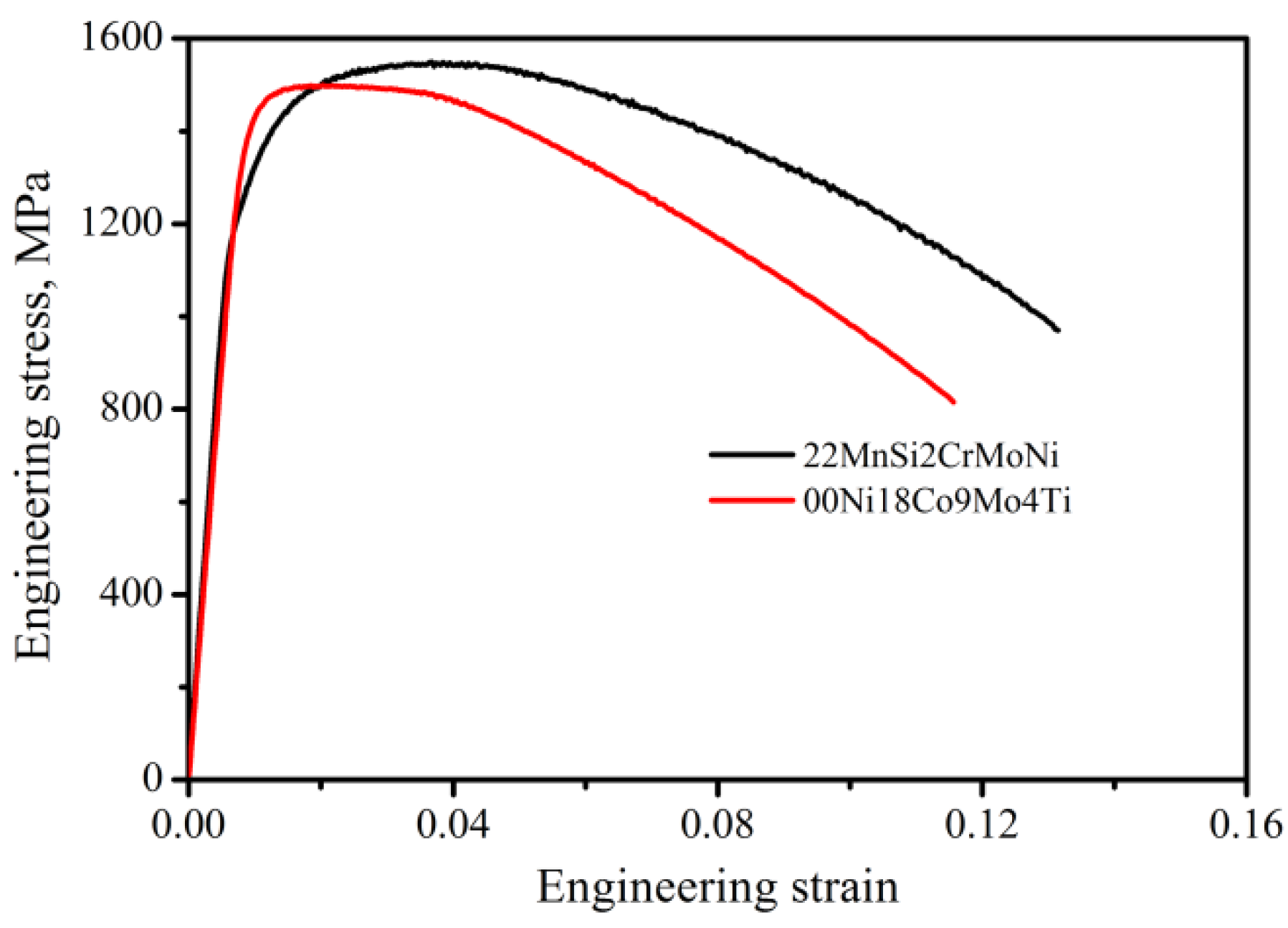
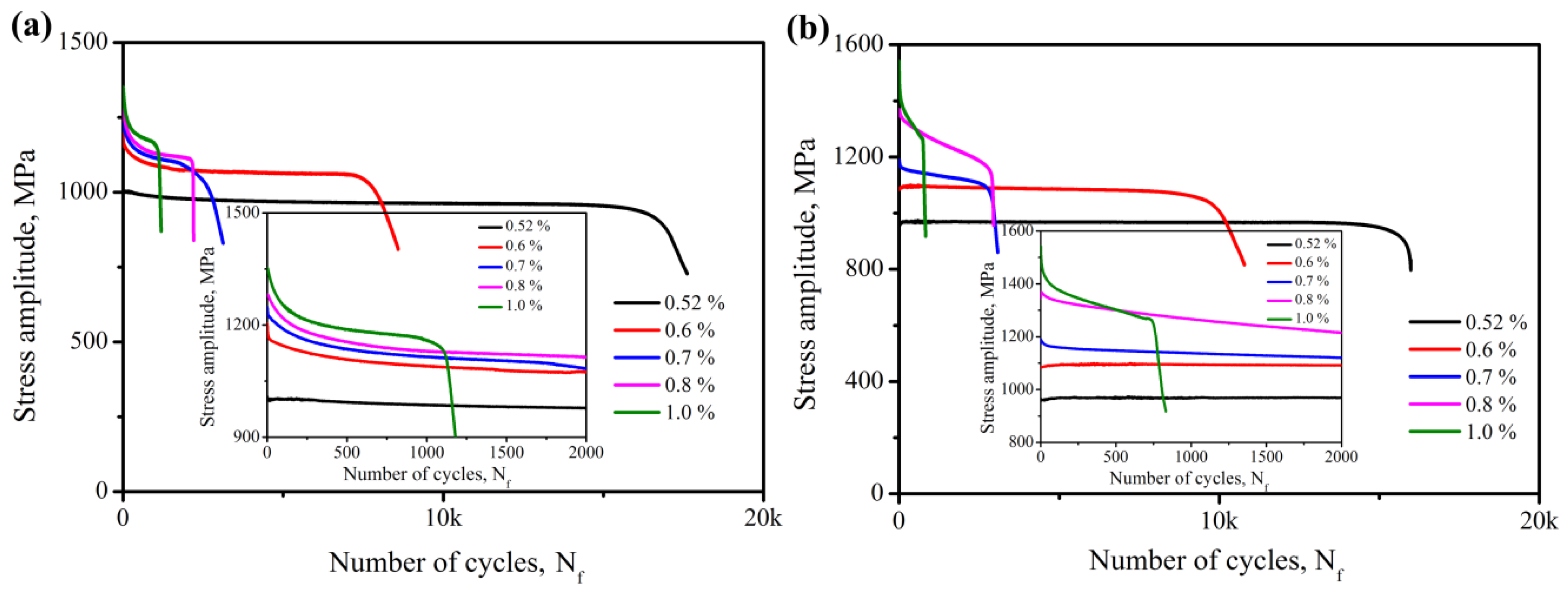
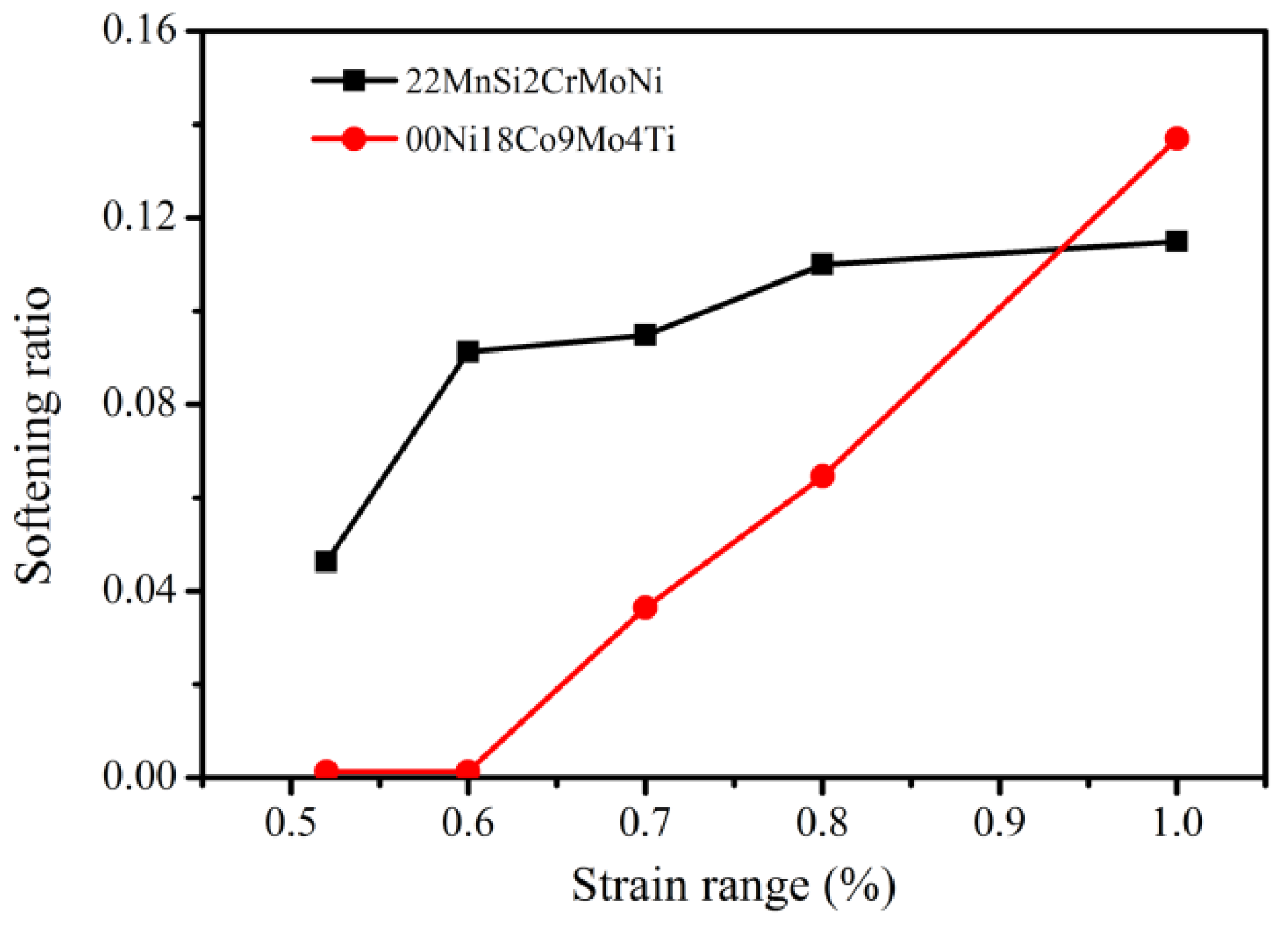

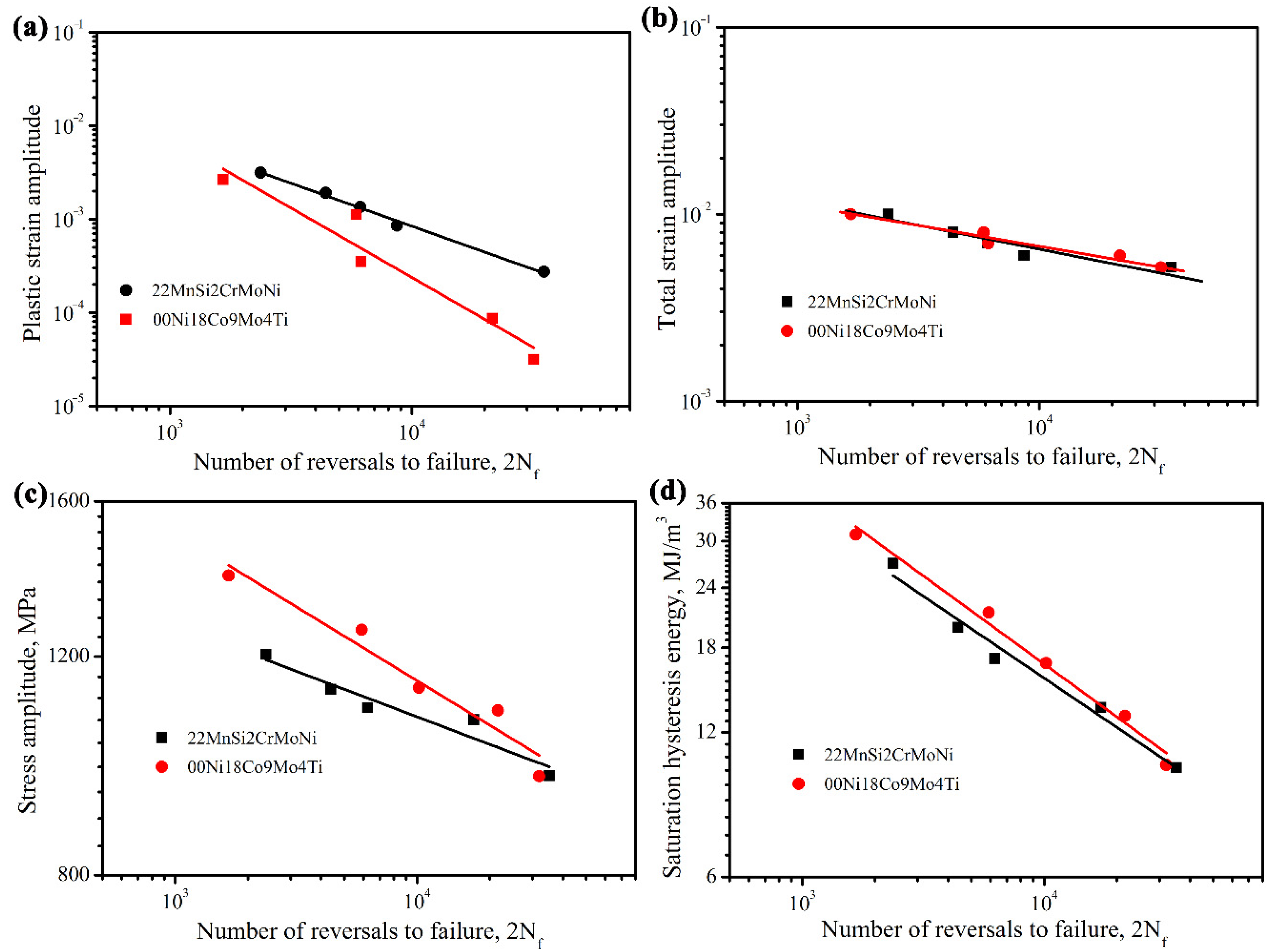
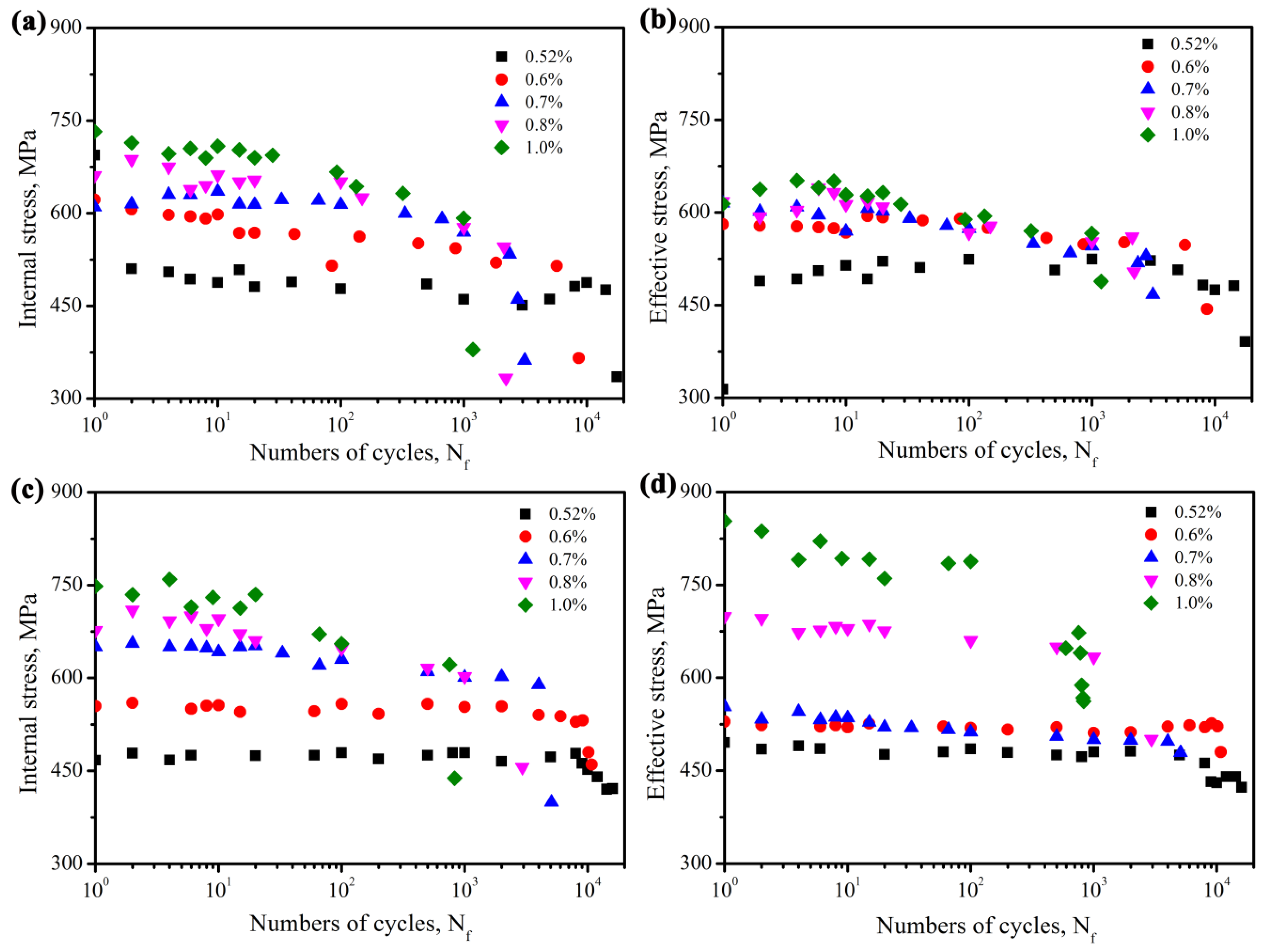

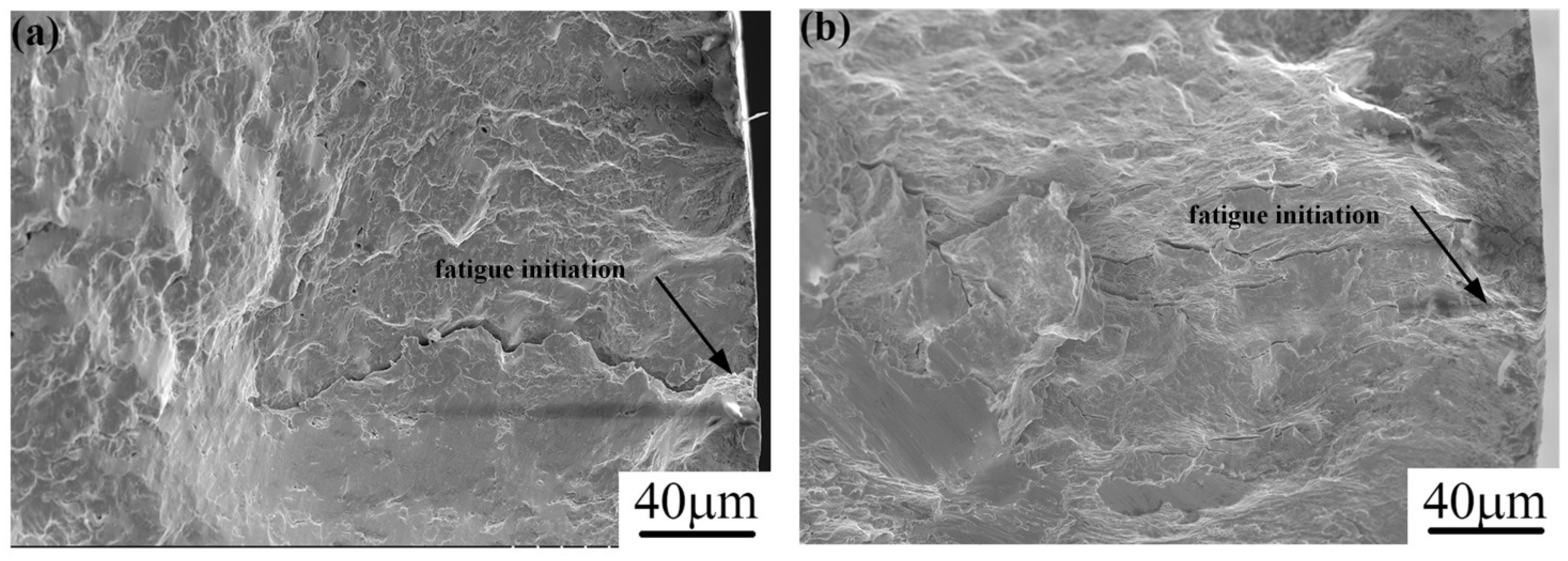
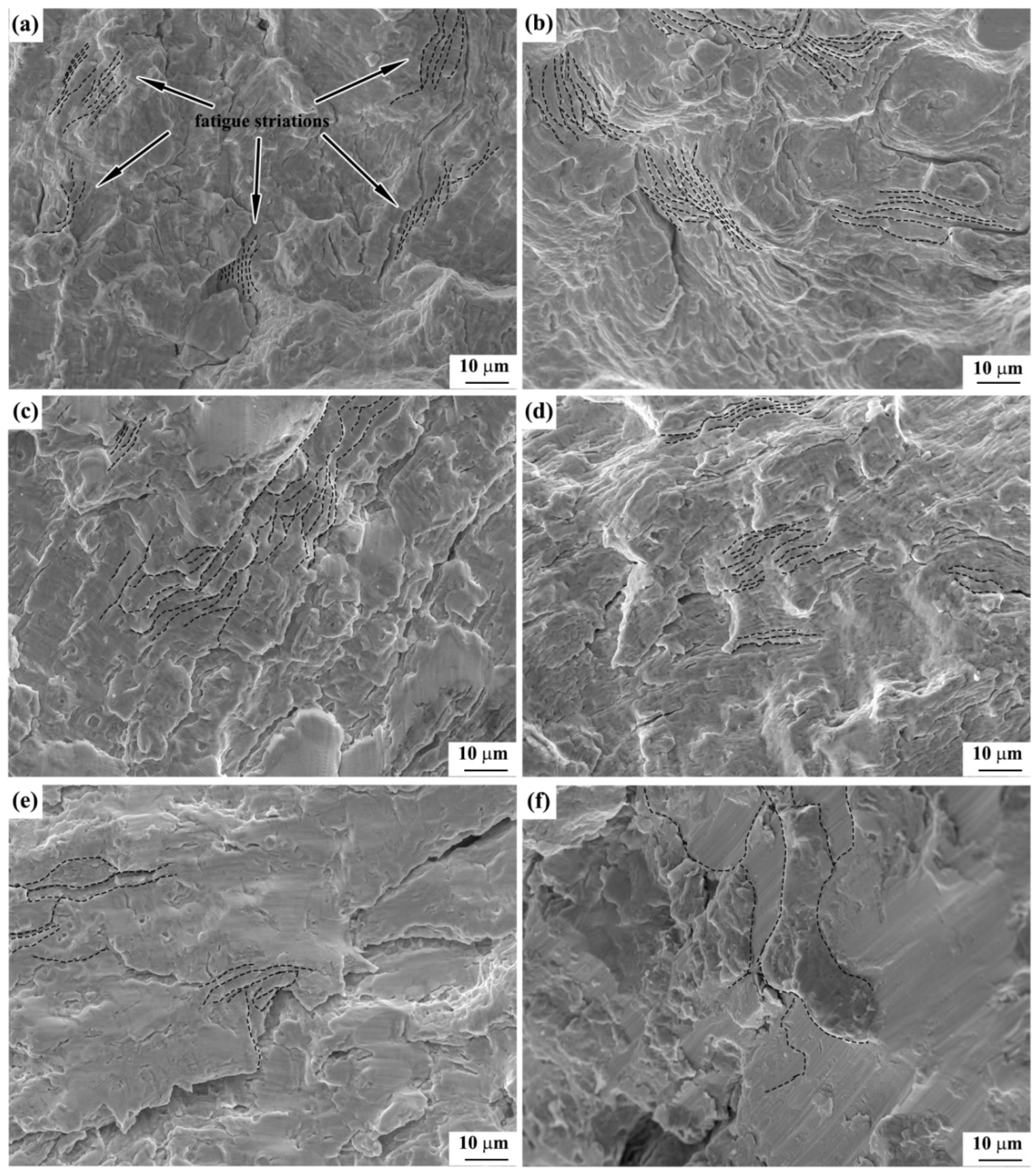
| Steel | C | Mn | Ni | Co | Mo | Si | Cr | Ti |
|---|---|---|---|---|---|---|---|---|
| 22MnSi2CrMoNi | 0.21 | 1.08 | 0.14 | - | 0.19 | 1.79 | 0.74 | 0.003 |
| 00Ni18Co9Mo4Ti | <0.001 | <0.001 | 17.50 | 8.4 | 4.32 | 0.01 | 0.12 | 0.182 |
| Steel | HRC | σs (MPa) | σb (MPa) | δ (%) | akU (J/cm2) | δ × σb (GPa·%) |
|---|---|---|---|---|---|---|
| 22MnSi2CrMoNi | 48.3 | 1261 ± 8 | 1548 ± 14 | 13.2 ± 0.4 | 120 ± 7 | 16.6 |
| 00Ni18Co9Mo4Ti | 44.9 | 1426 ± 9 | 1496 ± 15 | 11.6 ± 0.3 | 105 ± 8 | 16.5 |
| Tested Steel | (MPa) | (mm/mm) | (MJ/m3) | |||
|---|---|---|---|---|---|---|
| 22MnSi2CrMoNi | 2114 | −0.74 | 4 | −0.92 | 361 | 2.93 |
| 00Ni18Co9Mo4Ti | 3437 | −0.12 | 213 | −1.49 | 488 | 2.73 |
Publisher’s Note: MDPI stays neutral with regard to jurisdictional claims in published maps and institutional affiliations. |
© 2022 by the authors. Licensee MDPI, Basel, Switzerland. This article is an open access article distributed under the terms and conditions of the Creative Commons Attribution (CC BY) license (https://creativecommons.org/licenses/by/4.0/).
Share and Cite
Lv, B.; Xia, S.; Zhang, F.; Yang, G.; Long, X. Comparison of Novel Low-Carbon Martensitic Steel to Maraging Steel in Low-Cycle Fatigue Behavior. Coatings 2022, 12, 818. https://doi.org/10.3390/coatings12060818
Lv B, Xia S, Zhang F, Yang G, Long X. Comparison of Novel Low-Carbon Martensitic Steel to Maraging Steel in Low-Cycle Fatigue Behavior. Coatings. 2022; 12(6):818. https://doi.org/10.3390/coatings12060818
Chicago/Turabian StyleLv, Bo, Shule Xia, Fucheng Zhang, Guang Yang, and Xiaoyan Long. 2022. "Comparison of Novel Low-Carbon Martensitic Steel to Maraging Steel in Low-Cycle Fatigue Behavior" Coatings 12, no. 6: 818. https://doi.org/10.3390/coatings12060818
APA StyleLv, B., Xia, S., Zhang, F., Yang, G., & Long, X. (2022). Comparison of Novel Low-Carbon Martensitic Steel to Maraging Steel in Low-Cycle Fatigue Behavior. Coatings, 12(6), 818. https://doi.org/10.3390/coatings12060818






